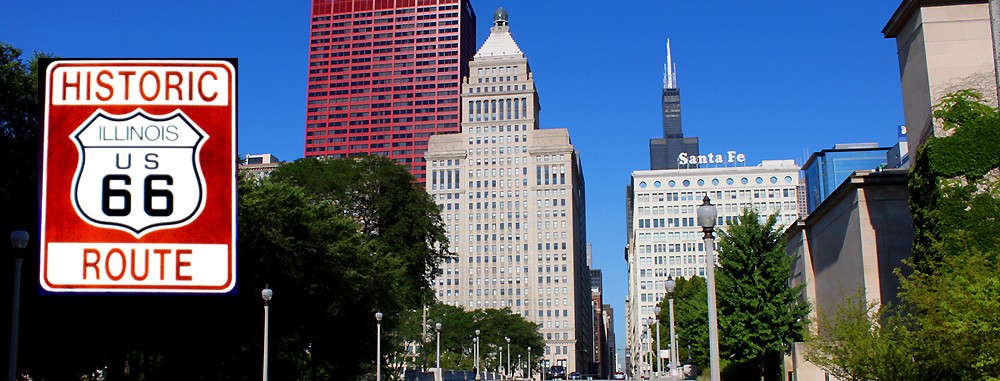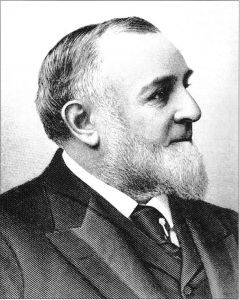Welcome! When we left you last time, the Tremont House had just succumbed to the Great Chicago Fire. John B. Drake, founder of the Drake hotel dynasty, was associated with the Tremont House hotel until 1873, when he bought the lease and furnishings of the rebuilt Grand Pacific Hotel and was once again able to offer his guests a high standard of luxury and service. Thus, Drake was able to conduct his annual great game dinners every Thanksgiving in three successive locations: the two Tremont Houses and the Grand Pacific on Jackson Boulevard, which became an unofficial salon for wealthy Republicans, just as the Palmer House was a hangout for the city’s affluent and powerful Democrats.
Those great game dinners might have lasted years longer had Drake not unexpectedly butted heads with another famous Chicagoan, one who had a mercenary attitude on real estate: Levi Z. Leiter, a former partner of Marshall Field. Field and Leiter had a troubled professional relationship. In 1881, they disagreed one time too many over business strategy: Leiter thought the wholesale business was more important than retail, which he dismissed out of hand, whereas Field knew that high-level urban retail directed primarily at women would make a lot more money. Field decided he’d had enough of his disputatious partner and bought out Leiter, then set about refashioning the company’s strategy and renaming the firm after himself. Leiter retired from the merchandising business and from then on focused on his real estate holdings and service organizations.
While in partnership with Potter Palmer, Field and Leiter had both learned a thing or two from Palmer about acquiring property. By the time Field and Leiter split, between them they owned more real estate than anyone else in Chicago – including Palmer. Leiter especially was hungry for property and rents. Former Chicago Plan Commission chairman Miles L. Berger describes Leiter as “one of the city’s most insatiable landlords,” which is a polite way of saying Leiter liked to jack up the rents whenever possible. Although one of his contemporaries called him a man whose “great aim was to be a model citizen, and not to accumulate great wealth,” Leiter’s behavior in business belied that. Especially telling was the episode about the Grand Pacific Hotel.
Here, we have to back up a bit. The Grand Pacific had been rebuilt after the Great Fire by the Pacific Hotel Company, which had also built, run and fully owned the original hotel and the land beneath it. When the hotel was rebuilt, Pacific Hotel leased the property to new hotel operators – John Drake and his partner Samuel Parker, who then acquired the furnishings. So far, so good. At some point after that, however, the ownership of the building and the land beneath changed. Whether this happened because the Pacific Hotel Company needed funds or for some other reason is unclear, as is when it occurred. However, by 1886, the western half of the Grand Pacific and the land under it were owned by Northwestern University. Pacific Hotel owned only the eastern half of the building, whereas the land beneath that was owned by the Philip F.W. Peck estate (Peck was another dry goods salesman – Chicago’s first great merchant, having begun in 1832 – who left retailing to became a real estate mogul; in fact, Peck was the model for Potter Palmer).
Enter Levi Leiter. In 1886, Leiter bought the land under the eastern half of the Grand Pacific from the Peck estate, which was managed by his sons (Peck himself had died two weeks after the Great Fire). Almost immediately, Leiter invoked a reappraisal clause in the property lease to justify raising the rent charged to Pacific Hotel on his half of the land. Pacific Hotel replied that in that case, they didn’t want to lease the land anymore and encouraged Leiter to buy the building himself and then to let the Grand Pacific transfer the building lease to Drake and Parker (yes, we’re talking about two different leases here: one for the land, which the building owner had to pay, and one for the building, which the hotel operators had to pay). Leiter would have been thrilled to become John Drake’s landlord, but he refused to buy the eastern half of the building, complaining that half a building was worthless to him.
What Leiter was really hoping was that when the land lease expired in four years (1890), the hotel would be his by default. Well, his half of the hotel, anyway. But it didn’t work out that way: the railroads that owned Pacific Hotel, the Lake Shore and Rock Island lines, were successful in getting the matter put before a three-man arbitration panel … and who should be a member of that panel but Leiter’s long-suffering nemesis (you guessed it), Marshall Field. Field, who still remembered how Leiter’s willful inflexibility on lease negotiations had almost prevented them from relocating their department store on State Street after the fire, took the opportunity to stick it to his former headache, and the panel ruled in favor of Pacific Hotel Company. Leiter was forced to buy the eastern half of the building from Pacific Hotel.
Now that he was half owner of the hotel, Leiter decided he could turn around and stick Drake and Parker with a rent increase. However, Drake’s lease wasn’t due to be renewed until May 1895, and Drake didn’t take the news of a rent increase well. He informed his landlords – Leiter and the university – that they’d have to make half a million dollars’ worth of improvements if they wanted to keep himself and Parker as tenants. The stubborn Leiter replied that he’d rather tear down his half of the building and put up an office tower instead. Drake wasn’t moved by this response: the country was in a deepening depression in 1894, there was very little demand for office space, and the new city ordinance limiting building heights made putting up tall office towers a bad investment. So Drake called Leiter’s bluff and didn’t budge.
Observers all thought a compromise would be reached; they assumed that Northwestern, as half owner, would act to assuage tempers and protect its investment. But the hard-headed Leiter wouldn’t back down. A month before the lease was up, Drake began selling the hotel furnishings. Leiter still wouldn’t blink. In May when the lease expired, Drake informed Leiter that he and Parker weren’t going to meet the new terms, closed the Grand Pacific, and left the hotel business forever. Thus ended the great game dinners. The old guard of Chicago’s social aristocracy and many others never forgave Leiter for destroying a popular Chicago tradition.
The end of his enterprise must have broken John Drake’s heart, however, because six months later, the master hotelier died, leaving behind a $2 million estate. His sons, Tracy C. Drake and John B. Drake Jr., who had grown up around the hotel business, learned it by their father’s side and had expected to have careers at the Grand Pacific, were denied that (they did go into the hotel business 13 years later, however, and ran first the Blackstone Hotel, a project they originated and helped develop, then the Drake Hotel).
The now ever-more-unpopular Leiter quickly discovered that Northwestern didn’t want him as a partner, either. Shortly after the Grand Pacific closed, the university’s half of the building, which faced La Salle Street, was demolished to make way for the new Illinois Trust and Savings Bank headquarters, designed by D.H. Burnham & Co. and only two stories tall. Coincidentally, this institution was one in which Leiter was heavily invested and for which John Drake’s elder son, Tracy, worked as a bond salesman for a short time. Leiter couldn’t operate with half a building, so he must have torn down his side as well and rebuilt, because a newer, smaller, plainer Grand Pacific Hotel reopened three years later and lasted until 1921. That building, too, was gone by 1926.
The low-slung bank building turned out to be unlucky for its investors, by the way. One day, an out of control zeppelin crashed through the building’s roof and killed a lot of people. But that’s another story …
Until next time!
Your own Route 66 historian,
Marie



